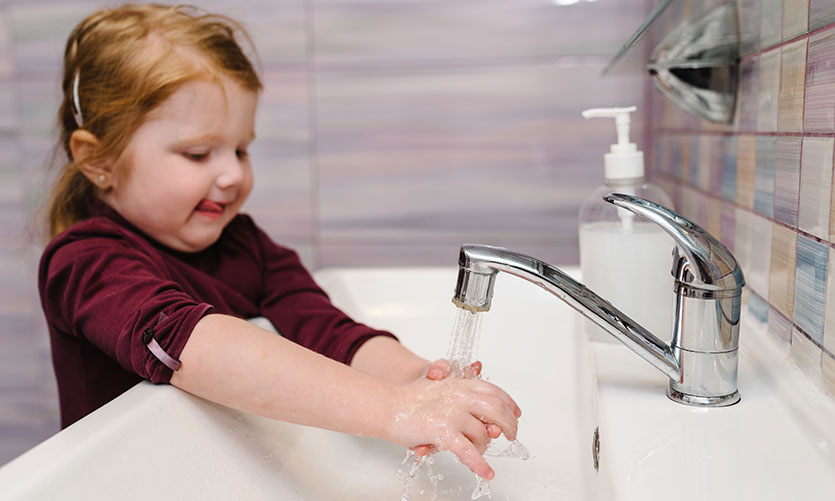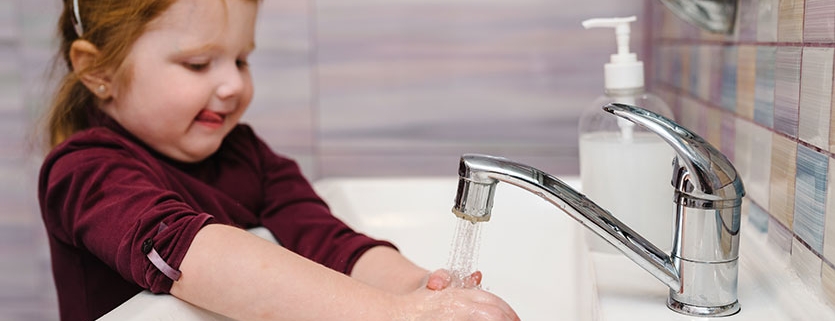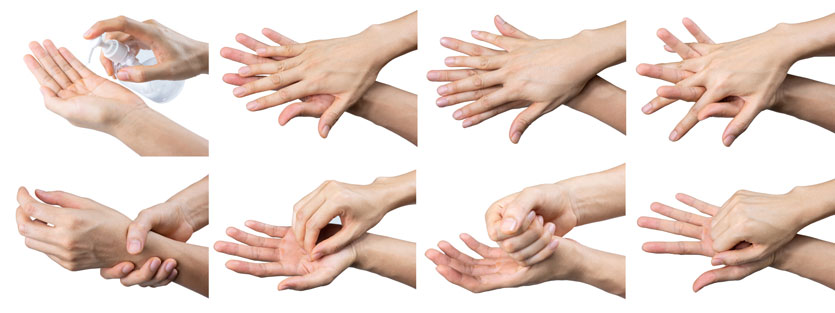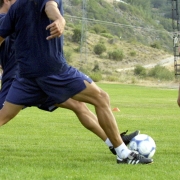Protect Yourself with Proper Handwashing Technique

You share the world with all kinds of viruses and microbes (collectively called germs). This includes some that are pathogenic—meaning they can produce disease. And once on your hands, these germs can easily spread to other areas on your body or transfer to other people or surfaces. That’s why healthcare professionals strongly recommend washing your hands frequently. And this isn’t a task to be taken lightly, done halfheartedly, or without proper handwashing technique.
That’s because doing a good job washing with soap and water neutralizes microbes lingering on your hands just waiting for an opportunity to enter your body. (Using an alcohol-based hand sanitizer is also another option to kill germs—more about that later.) Handwashing is a quick, easy, and effective way to prevent the spread of germs. Unfortunately, many people don’t wash their hands often enough or do it correctly.
A study in the Journal of Environmental Health looked at the handwashing techniques of 3,749 people using public restrooms. The shocking results found that while 67 percent washed with soap and water, only five percent did it long enough to remove germs lurking on their hands. Twenty-three percent rinsed their hands, but did not use soap. And 10 percent did not wash their hands at all after using the toilet.
The Early History of Handwashing
The importance of hygiene was recognized in the early 19th century. Several prominent scientists made important discoveries in microscopy, microbiology, and disease prevention during this time. But Ignaz Semmelweis, a noteworthy Hungarian doctor, was the one who discovered the importance of handwashing in the healthcare setting.
Dr. Semmelweis found that requiring his medical staff to clean their hands and instruments with soap and a chlorine solution between performing autopsies and caring for maternity patients, decreased the rate of illness and death dramatically in the women and their newborns. Because of this discovery, some consider Dr. Semmelweis the father of hand hygiene.
During a speech in 1850 at the Vienna Medical Society’s lecture hall, Dr. Semmelweis shared his discoveries. He strongly advised colleagues to wash their hands to prevent the spread of disease. Unfortunately, the medical community at large didn’t heed this advice for several decades—after countless lives were needlessly lost.
Highlighting the Importance of Hand Hygiene
Germs live in you, on you, and everywhere in the environment—especially frequently touched surfaces. Throughout the day, it’s common to pick up all kinds of germs from the air you breathe, objects you touch, and people you meet. And while your skin can provide a protective barrier against these microbes, the protection only goes so far. Absentmindedly touching your eyes, nose, and mouth—a habit everyone is guilty of, and that’s difficult to break—occurs approximately every two and a half minutes.
This number isn’t a guess. It comes from a study in medical students published in the American Journal of Infection Control. The study found students touched their faces an average of 23 times per hour. And almost half of these hourly touches involved contact with a mucous membrane (eyes, nose, or mouth).
Ask yourself: how many times a day are you touching your face?
It’s an important question. Hands are a portal for bad germs to sneak inside you and potentially make you sick. It’s been estimated that 80 percent of infectious diseases are spread by touch. And since it’s not realistic to wear a hazmat suit every day, it’s important to frequently use proper handwashing technique (thoroughly with soap and water or using an alcohol-based hand rub).
Why? Effective hand hygiene neutralizes germs that may lurk on your hands. Soap and water are actually the best option, but alcohol-based sanitizer is a good backup when handwashing isn’t possible. While not dangerous, children under the age of six should have adult supervision when using a hand sanitizer. It’s also important to follow the directions for use listed on a sanitizer’s Drug Facts panel.
The Power of Proper Handwashing Technique
Quickly rubbing and moving your hands under running water may feel like proper handwashing technique, but it’s not sufficient to achieve adequate clean. It’s best to take a few extra seconds to properly wash with soap and water. And doing it correctly could make the difference between staying healthy and becoming ill with a preventable infection.
Experts recommend scrubbing hands (to create friction) for at least 20 seconds or as long as it takes to sing “Happy Birthday” twice. The type of soap isn’t as important as the handwashing technique, meaning the regular stuff works just as well as antibacterial soap as long as you follow the handwashing steps below.
This approach is effective because soap is made up of pin-shaped molecules that have a hydrophilic head (water attracting), and hydrophobic tail (water repelling). Soap molecules can act as a bridge connecting the hydrophilic head to a water molecule and the hydrophobic tail to lipids and germs that may lounge on your hands.
When you wash your hands with soap and water, you surround the germs with soap molecules. The soap’s hydrophobic tails, in an attempt to avoid water, attach themselves to germs, and this effectively neutralizes them. While viruses aren’t technically alive, soap molecules compete with the lipids on and within the virus membrane to help pry it apart, rendering it harmless.
Finally, rinsing off the soap with water washes the vast majority of these germs down the drain.
Handwashing Steps with Soap
Now that you know why it’s important to practice proper handwashing techniques, let’s talk about the steps to complete this important task.
- Start by wetting your hands with clean, running water (warm or cold), and then apply soap.
- Create a lather in your hands by rubbing them together with the soap to create friction. Rub the lather on your palms and the backs of your hands. Make sure to go around and between all of your fingers and both thumbs. Move down your fingers to include the tips and nail bed. And even clean under the tips of your nails, as applicable.
- Continue this scrubbing and rubbing motion for at least 20 seconds. A good timer for completing this task is singing or humming the “Happy Birthday” song from beginning to end twice. You can also sing or hum the song of your choice, set your phone timer, or count. Just make sure to scrub until you at least hit the important 20-second mark.
- The next important step is to thoroughly rinse your hands under clean, running water.
- And finally, dry your hands using a clean towel (or paper towel). You can also allow them to air dry. But don’t dry them on your clothes.
Hand sanitizer (foam or gel) is the next best solution to clean hands when you can’t wash with soap and water. It’s important to ensure any dirt or grime on your hands is removed before using hand sanitizer.
- Apply about a dime-sized amount of waterless hand sanitizer (with an alcohol content of at least 60 percent) to the palm of one hand.
- Rub hands together to create friction, covering all hand surfaces, and focusing in particular on the palms, thumbs, fingertips and fingernails, until dry. The amount used should take at least 15 seconds to dry completely.
Now that you know how to correctly perform this health-maintenance activity, remember to do it often. The scientific evidence overwhelmingly supports proper handwashing technique as the simplest and most important way to help reduce the risk of infection. Adopting this important habit can play an important role in protecting your overall health, and the health of your family and friends.
References
https://www.ncbi.nlm.nih.gov/pubmed/25637115
https://www.ncbi.nlm.nih.gov/pmc/articles/PMC3249958/
https://pubmed.ncbi.nlm.nih.gov/12726975/
https://www.medicalnewstoday.com/articles/proper-hand-washing
https://www.nytimes.com/2020/03/13/health/soap-coronavirus-handwashing-germs.html
https://www.cdc.gov/handwashing/
https://www.fda.gov/drugs/information-drug-class/qa-consumers-hand-sanitizers-and-covid-19
https://www.mayoclinic.org/healthy-lifestyle/adult-health/in-depth/hand-washing/art-20046253
https://www.educationworld.com/a_curr/School-Wide-Handwashing-Campaigns-Cut-Germs-Absenteeism.shtml
https://www.cdc.gov/handwashing/show-me-the-science-handwashing.html














